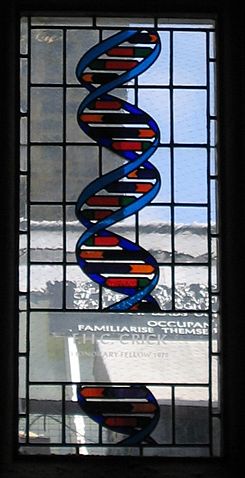 |
This is a file from the Wikimedia Commons. Information from its description page there is shown below.
Commons is a freely licensed media file repository. You can help.
|
Summary
| Description |
Stained glass window in the dining hall of Gonville and Caius College, in Cambridge (UK), commemorating Francis Crick, who co-discovered the molecular structure of DNA, received a Nobel Prize and was an honorary fellow of the college. The window represents a double helix; the text on the windows reads: F.H.C. CRICK, HONORARY FELLOW 1976. |
| Date |
28 April 2006 |
| Source |
Own work (Photo by myself) |
| Author |
User:Schutz. The stained glass was designed by Maria McClafferty and installed between 1992 and 1993. |
Permission
( Reusing this file) |
CC-BY-SA-2.5
|
Some more information about the stained glass window (thanks to User:Nitramrekcap on en.wikipedia.org), from the article " Caius Stained Glass", by Anthony Edwards, in "Once a Caian", issue 2, September 2005, 12–13.
"..Crick gave his blessing (provided Watson agreed and as long as the window was not visible from outside at night, for the DNA would be coiling the wrong way.).."
"Francis Crick, co-discoverer of the structure of DNA with James Watson, and Nobel Prizewinner, is commemmorated by a diagram of the double helix based with permission on a 1989 Swedish stamp."
Licensing
|
I, the copyright holder of this work, hereby publish it under the following license:
|
File usage
The following pages on Schools Wikipedia link to this image (list may be incomplete):
SOS Children's Villages has brought Wikipedia to the classroom. More than 2 million people benefit from the global charity work of SOS Children, and our work in 133 countries around the world is vital to ensuring a better future for vulnerable children. There are many ways to help with SOS Children.


